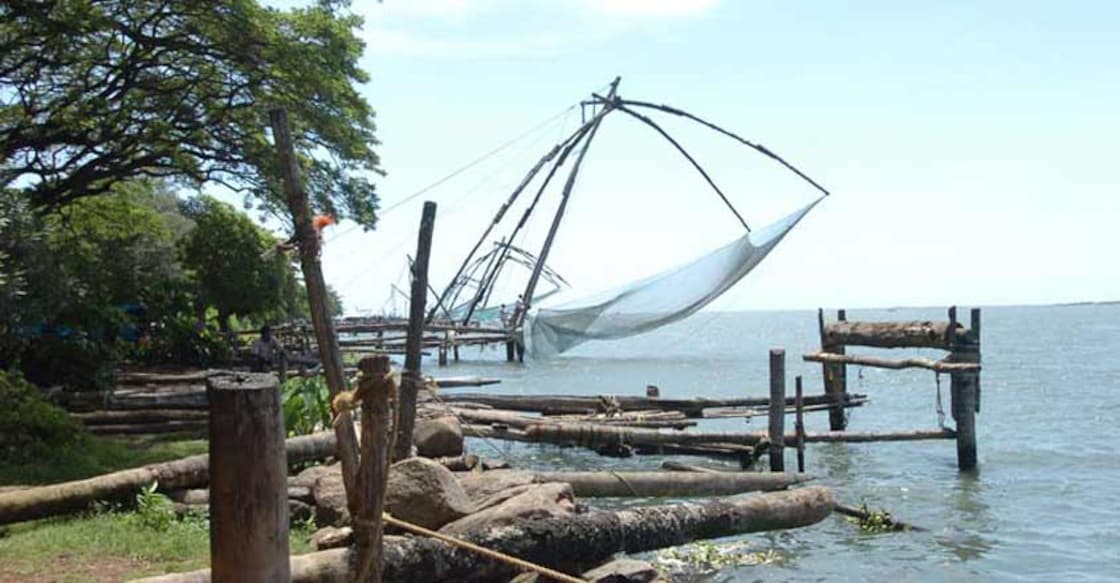When Chinese travellers enriched Kerala's cultural melting pot

Mail This Article
Many years ago when I played a CD with Chinese New Year songs, my sister remarked that the music sounded similar to Communist party jingles in Kerala. Mao's revolution was indeed a source of inspiration for some Malayalis, but the 1962 war and the wounds it inflicted on the Indian psyche pushed Kerala communists in the direction of Russia. Kerala's links with the Middle Kingdom go way back and predate communism by centuries.
One does not have to be an anthropologist to spot the Chinese influence and heritage in Kerala. One of Kochi's most famous tourist attractions is the Chinese fishing net.
Many a picture postcard shows the stationary lift nets in the background of golden twilight. These nets first sprang up in Kerala in the 14th century, and some historians believe that the great Chinese mariner and diplomat Zheng He introduced them in the region.
The explorer, whose expeditions predate and dwarf those of Christopher Columbus and Vasco da Gama, visited Kozhikode a few times. Maddy’s Ramblings, a treasure trove of a blog for history lovers, writes in detail about Zheng He’s visits to Kozhikode (then called Calicut).
“They (the Chinese) picked up spices of course, but only on the journey eastwards back to China,” Maddy writes. “They did stop over in Calicut on each of the seven voyages, recuperated, replenished their stores and continued on frequently to the west. For the westerly trade, they bartered in Calicut with gold coins, spices from Southeast Asia and mainly rice that they had picked up at Orissa, to purchase silver for the trip to Zanzibar.”
Zheng He died during a voyage near Kozhikode and was probably buried at sea. Ji Louoyan, a researcher from the Palace Museum of China, who visited Kerala as a part of a delegation in 2015, told a local paper that there was evidence in Chinese historical texts that Zheng He was fond of Kerala.
A few residents of Kochi have told me that the city got its name from the Chinese mariner who felt the place reminded him of China (co-chin), but a Chinese scholar I spoke to laughed off the idea, saying that one could argue that Kochi in Kerala has some ancient connection with a Japanese city with the same name!
Chinese historians believe that Zheng He’s armadas were floating cities that comprised of more than 60 ships and more than 20,000 people. It is possible that some of these Chinese sailors who called on ports in Kerala stayed back in places like Thangassery in Kollam. Archaeologists have managed to dig up ancient Chinese coins and artefacts in the area.
Whether Chinese people did stay back in Kerala or not, their presence did manage to create an impact in the state, which has for millennia absorbed influences from many parts of the world.
To the naked eye, there are strong similarities in the traditional architectural styles of Kerala and China, and one would be tempted to think they influenced each other, but the fact is that the origin of the Pagoda (Bhagwati) style architecture is Nepal. The Newars are believed to have spread this style to the far corners of East Asia as well as to Kerala.
However a famous temple in Beijing looks like a long-lost cousin of a Ganesha and Shiva temple in Kasaragod. I am referring to the Temple of Heaven, which was constructed in the first half of the 15th century and the Madhur Temple, which has probably existed since the same time period, although some of the surrounding constructions are newer.
Culinary impact
The 'cheenachatti', the deep, thick and circular cooking pot that is integral to Kerala cuisine, literally means Chinese pot in Malayalam. Our humble 'cheenchatti' is basically a Chinese wok, but instead of just being used to stir-fry, the Kerala version is better suited to simmering curries.
The influence of food from the Middle Kingdom is visible to this day in a Malayali kitchen. The traditionalists among us love koyukattas, dumplings that are similar to dim sum.
Nool puttu, another favourite, is nothing but our own version of noodles that existed long before Nestle made Maggi a household name in India. Why do we call our porridge kanji, which is similar to the Cantonese congee?
Two-way traffic
The cultural exchanges that took place between Kerala and China were mutually enriching. Bodhidharma, the 5th-century Buddhist monk from Kerala took both Mahayana Buddhism and kalaripayattu to China.
Tour guides at the Shaolin Monastery in China happily talk about the Indian origin of kung fu, which is what the Kerala-origin martial art evolved into.
It is also very likely that pilgrims and spiritual seekers from Kerala and Chinese provinces crossed paths near Mount Kailash and Lake Manasarovar at a time when the idea of the European nation state, national identity cards and borders didn’t exist in what was a culturally integrated Asia.
A greater amount of research would help Kerala and China rediscover their age-old links and help enhance cultural ties that trump geopolitics.


